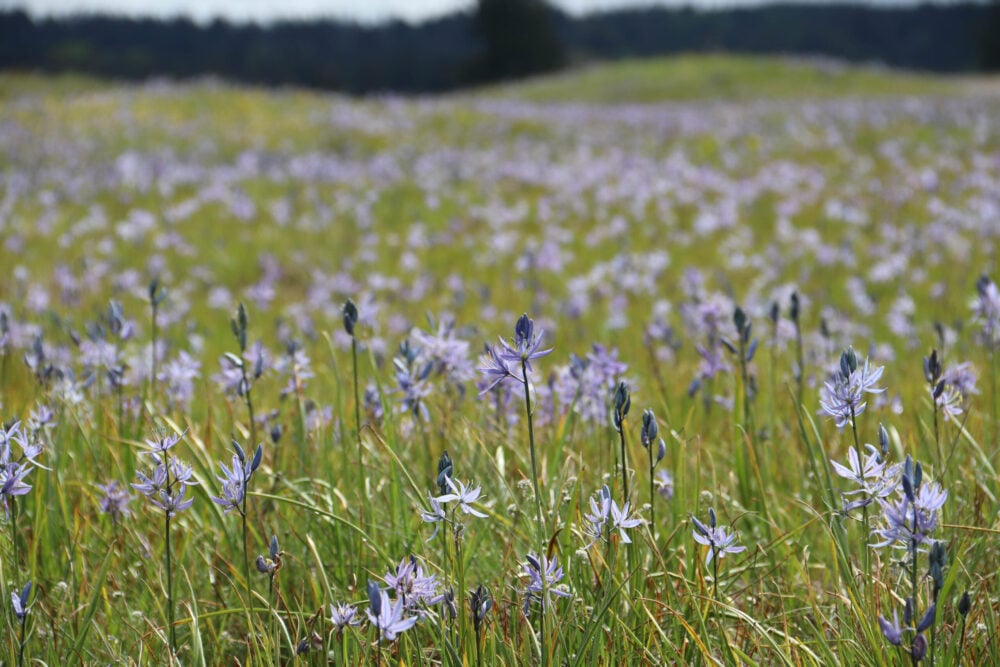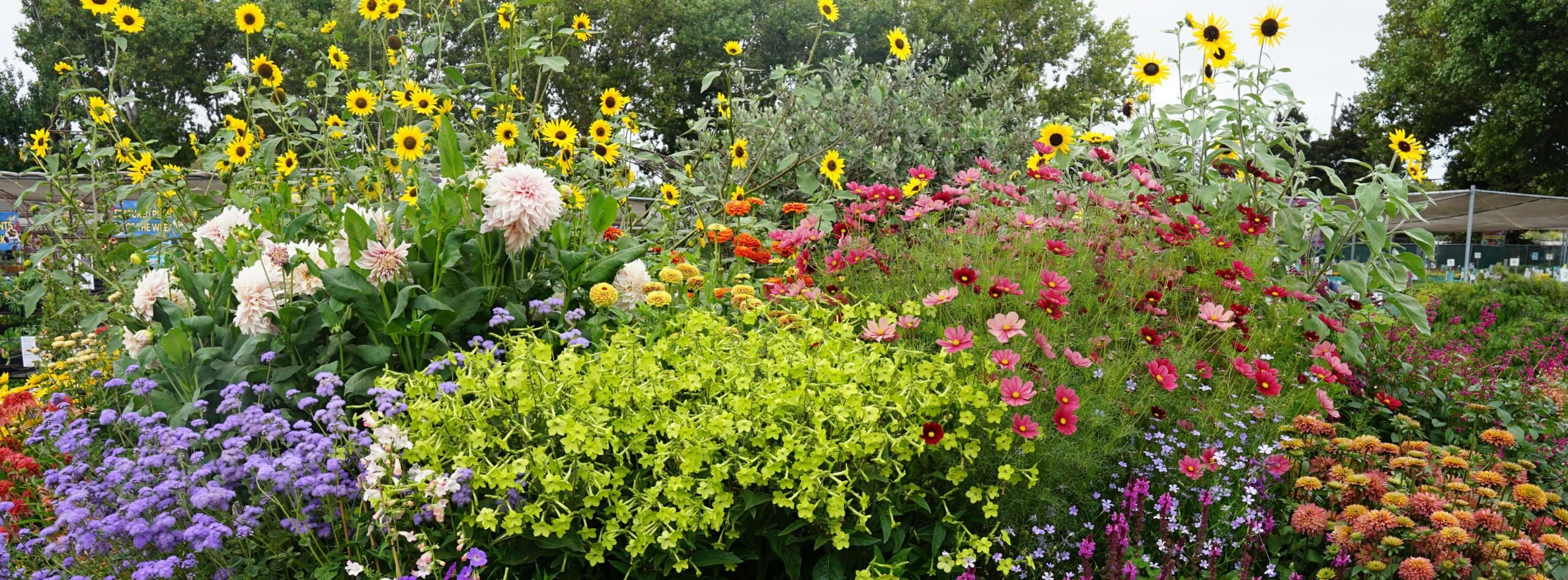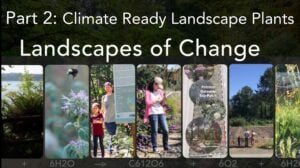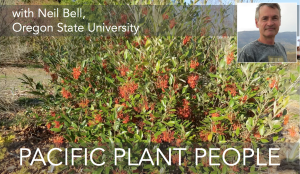
Seeding Community: The Bainbridge Food Forest Brings People Together

Contributor
Winter 2025
After lying fallow for 20 years, a 13-acre farm on Washington’s Bainbridge Island has found new life as an eco-friendly food forest. The Bainbridge Island Native Food Forest (BINFF) will soon nurture wildlife and grow community.
“In a perfect world I would love to see it grow and be used as a snack trail for all species,” said landscape architect Becca Hanson, founder of SH|R Studios, who is overseeing the design of the food forest. “The coyote walking by and snacking on Vaccinium [huckleberry] would be just fine with us. We want to celebrate the plenty available from the Pacific Northwest—native plants of all sorts—while also interweaving other plant species, particularly fruit plants.”


Agricultural roots
Managed today by nonprofit Friends of the Farms, in its former lives the site was first a strawberry farm owned by the Suyematsu family and then the M&E Christmas Tree Farm. When the tree farm’s owners donated the property to the City of Bainbridge Island in 2003, the deed only allowed noncommercial agriculture without permanent structures.
“It was a wild overgrown 13.5-acre parcel, and it still had trails and the stand where people would grow Christmas trees,” said Friends of the Farms Executive Director Heather Burger. Friends of the Farms manages many local projects, including a restoration of neighboring Morales Farm, which may one day connect to BINFF via trails.
“Friends of the Farms tried for years to find the right person, project, or thing that fit the criteria, and couldn’t figure out what to do with it.” In the meantime, neighbors, dog walkers, and families had been using the trails.
One day, when Burger was at a meeting about food security and disaster preparedness on the island, the idea of a food forest came up and the light bulb went off for the M&E farm site. The thinking was, “What if we thought about a place filled with native plants that are used by Indigenous populations that doesn’t have to be cultivated and is there for everyone—pollinators and people?”
Despite the challenges, Hanson said, “This has been the little project that roared.”
Planners knew this place was special and needed careful handling. The property links to the Manzanita Creek Watershed—which includes a significant aquifer on the island, a potential salmon-bearing stream, and prized bird habitat. From towhees and kinglets to barred owls and red-tailed hawks, 45 species have been spotted in the area, according to a hotspot on community science site eBird. It’s also a local wildlife corridor for bears, coyote, and deer.


To thoughtfully restore the ecosystem, Friends of the Farms crafted a master plan by consulting with the Suquamish Tribe, local farmers, as well as environmental experts at Xerces Society, Northwest Meadowscapes, and the Kitsap Audubon Society. Ultimately, the hope is to restore the natural streamway and native vegetation around the creek while connecting to existing trail networks to improve access to the area.
“Having the Suquamish Tribe come out was such an incredible experience,” said Burger. “All of a sudden you see things in completely different way.” For example, she said, Azure Boure,
Traditional Food & Medicine Program Coordinator at Suquamish Tribe “was picking off the palest green fir tips and collecting them in her hand, because she said fir tips have more antioxidants than pretty much anything.”
Early on, it became clear the transformation was going to take years.
“You’re taking something that had the imprint of human hands on it,” said Burger. “It has diverged so far from the natural wild healthy ecosystem it was.” While Burger was initially imagining it might take 30 years to complete, the Xerces Society representative who inspected the site estimated 100.
The heart of the plan, recently planted, is the Snack Trail, a 300-foot-long hedgerow weaving blackcap raspberries (Rubus leucodermis), elderberries (Sambucus nigra ssp. canadensis), evergreen huckleberries (Vaccinium ovatum), and salmonberries (Rubus spectabilis).
When completed, this forgaging journey will skirt the existing ravine fed by Manzanita Creek into a planned pollinator meadow called the Central Meadow, then duck into shade for an edible Fungi Trail, before emerging at the West Meadow, an open gathering space for picnics, classes, and events. A stormwater retention pond, expected to begin construction late in 2025, will help recharge groundwater resources.

Although the plantings are still immature, “the BINFF is open to the public 365 days a year, sunup to sundown, and is utilized by walkers, birders, hikers, runners, nature lovers, and students,” Burger said. “The trails are used daily by many of the 90 households within walking distance and is very popular as one of the Island’s few public off-leash areas for dogs.”

The design is meant to enhance the site’s inherent beauty. “The light there is extraordinarily beautiful,” said Hanson. “It’s that quality of early morning light coming through the alders on one side and in the afternoon it comes though the Douglas firs and maples to the west. Its’s always changing.”
An outdoor classroom
Before planting came the tough work of clearing. Untended for years, the land grew thick with invasive plants like Himalayan blackberry (Rubus armeniacus) and Scotch broom (Cytius scopiarus).
In fact, a vocal portion of the community wanted to keep those blackberries, which had become cherished summer forage for the neighborhood. Burger and Hanson promise there will be berries aplenty for all once the plantings mature, while also welcoming pollinators and restoring a balanced ecosystem. The blackberries may never really be gone, thanks to birds who spread the seed around.


Burger said three elementary schools—The Island School, Blakely Elementary, and Ordway Elementary—have used the BINFF for onsite student learning. Inspiration struck during the pandemic, when Island School teachers were seeking outdoor learning spaces. This fall, 80 elementary students from The Island School began weekly onsite learning and ecosystem restoration projects in the BINFF that they will continue throughout the school year.

Christine Neukirk has been teaching at The Island School for seven years, since the BINFFF became the K-5 school’s daily outdoor classroom during the pandemic.
“We’d make observations, do writing sessions, and science experiments,” Neukirk said. “We really utilized that food forest every day. Once schools went back inside it became more like once a week. It’s a beautiful piece of land, there’s a grove of trees the kids adored no matter the weather. It’s pretty dry under the canopy so they played tag and all sorts of games in there. It was pretty magical.”
After getting almost the whole school to remove invasive plants, “We planted somewhere in the vicinity of 350–400 native species, including red-flowering currant (Ribes sanguineum) salal (Gaultheria shallon), Oregon grape (Mahonia aquifolium), red osier dogwoods (Cornus sericea), and osoberry (Oemleria cerasiformis).”
Neukirk’s third graders are working on meadow restoration. “This fall we are experimenting with wildflowers. Friends of the Farms tried to plant in spring, but it didn’t take. We think it was too dry. We’re hoping if we plant this fall the rain will help them get established,” Neukirk said.
Her class will work on the meadow for three years. “It’s more than an acre, I’d say, and there’s a lot to get out of it. They are going to be doing research on pollinators and the different species living there,” she said. There’s talk of planning a meditation area in the meadow.
Their time in the BINFF inspired in the indoor classroom’s Wonder Wall, depicting “things that stop you in your tracks,” like a praying mantis, an earwig, leaves, mushrooms, or memories of moments.
“It’s wonderful to see them ‘ooh’ and ‘aah’ at nature,” Neukirk said. “They are really noticing what’s around them. When you start drawing their attention and ask them to notice, its’s amazing and kind of contagious.”
Delicious by design
Design that blends with nature takes consideration. Hanson, a fellow with the American Society of Landscape Architects, is on the board of Friends of the Farms and has designed for zoos from Sacramento and Seattle to London and Aukland. Using that template as a model, she sought to craft a “tapestry of plants that look wild and natural but can take some abuse. It’s not your traditional landscape.”


Hanson takes inspiration from nature. “It’s really no harder than seeing which species are growing next to each other and see under what circumstances they like to grow.”
She said she keeps in mind, however, that nature will outmaneuver even the most meticulous design. “It’s hard to keep rules,” in natural plantings. “You never know what’s going to work in a situation like this. It’s cultivated but also wild planting.” For the best odds of success, she recommends overplanting to encourage plants to weave together, inhibiting weeds and sheltering birds.
When it comes to caretaking, “The plants are generally left on their own,” said Hanson.
The alder forest near the creek is the wettest, so it became the natural spot for the fungi forest. They plan to inoculate logs on the trail with mushroom spores.
“We get the city and parks district to help with mowing, so we get at least two mows a year,” Hanson added. She’s delighted to notice native seed popping up that had lain dormant in the soil all these years.
“Any other maintenance is done catch-as-catch-can,” she said, “In addition to the school programs, tree companies bring wood chips regularly.”
In 2022, a grant from the Rotary Club of Bainbridge Island funded a shed that holds tools fitting hands for all sizes and ages, according to the club’s website. Burger is also “writing a grant application this year to our local rotary to fund getting goats to come out to graze areas we can’t get to.”
Hanson is blown away by the community support for the food forest. “It’s been amazing; could never have done anything like this trying to get work parties together. This is a lot more laid back than the Beacon Food Forest, for instance,” she said, referring to Seattle’s pioneering urban food forest.
“It’s deeply affecting seeing these bits of nature, getting to see it change over time and to feel like your hand has been part of creating that future,” Hanson said. “Whenever you have anything that creates life and brings people together, everybody lays down their differences and gets with the whole spirit.”
This article was made possible by a Generous Grant from the Bainbridge Community Foundation.
More about Food Forests from Pacific Horticulture
At 10, Seattle’s Pioneering Food Forest Pivots to Increase Food Security
By: Erica Browne Grivas
What started as a student design project in permaculture became Seattle’s Beacon Food Forest—based on a simply radical, somewhat mind-blowing concept for urban planners: growing free food sustainably. This was not just a food forest, but a community food forest, open for foraging for all, located just two miles from downtown. Having just passed its tenth anniversary, where is the Beacon Food Forest today, and how is it changing? >> Read Article
Add Your Heading Text Here
For more information about Bainbridge Food Forest, visit Friends of the Farms and the food forest’s field guide.
SH|R Studios is overseeing the food forest’s design. The Suquamish Tribe, Xerces Society, Northwest Meadowscapes, Kitsap Audubon Society, and local farmers also contributed to design and planning.
For more information about the nearby Manzanita watershed, see this StoryMap by the City of Bainbridge Island.
Bainbridge Island Rotary. n.d. “Grant Awards.”
eBird. n.d. “Bainbridge–M & E Tree Farm.”
The Island School students. 2021. “Birds.” Bainbridge Island Native Food Forest Field Guide.










Responses